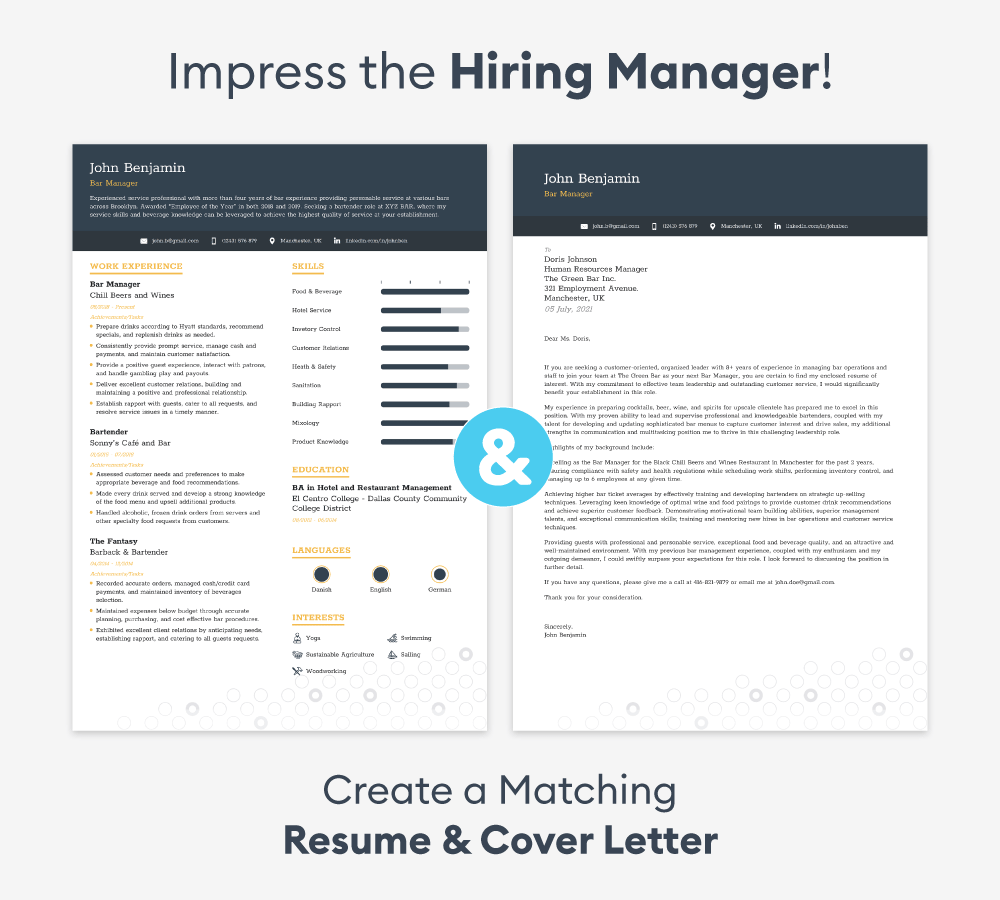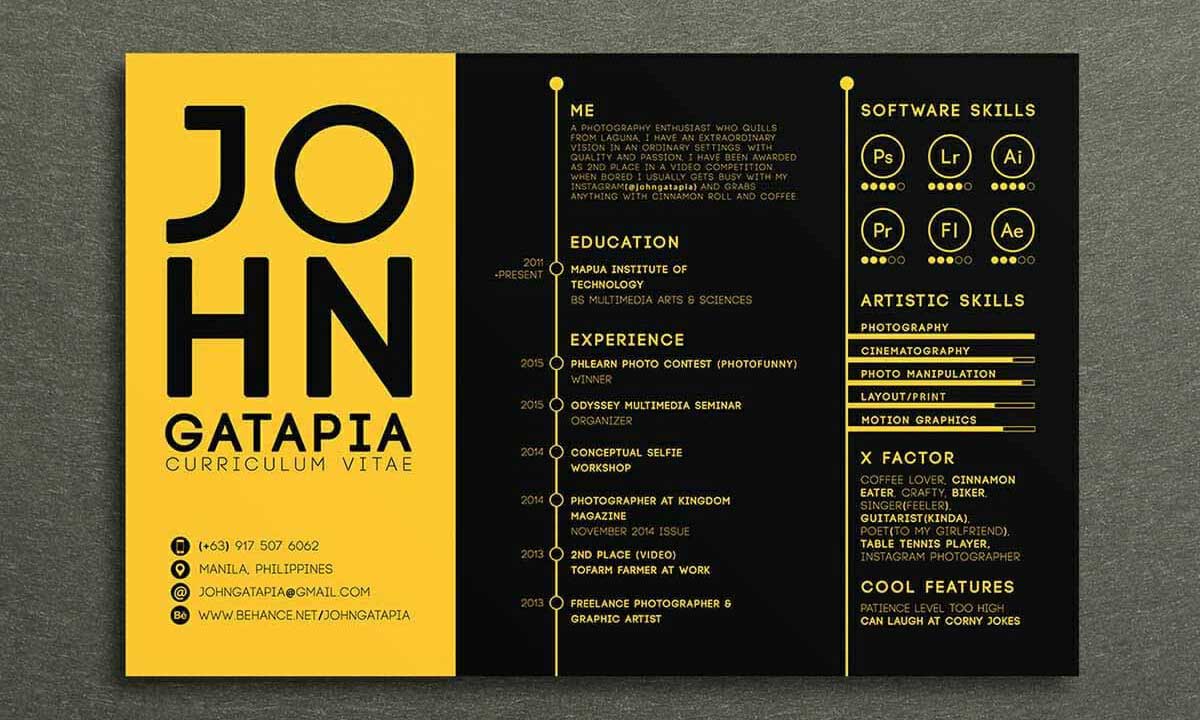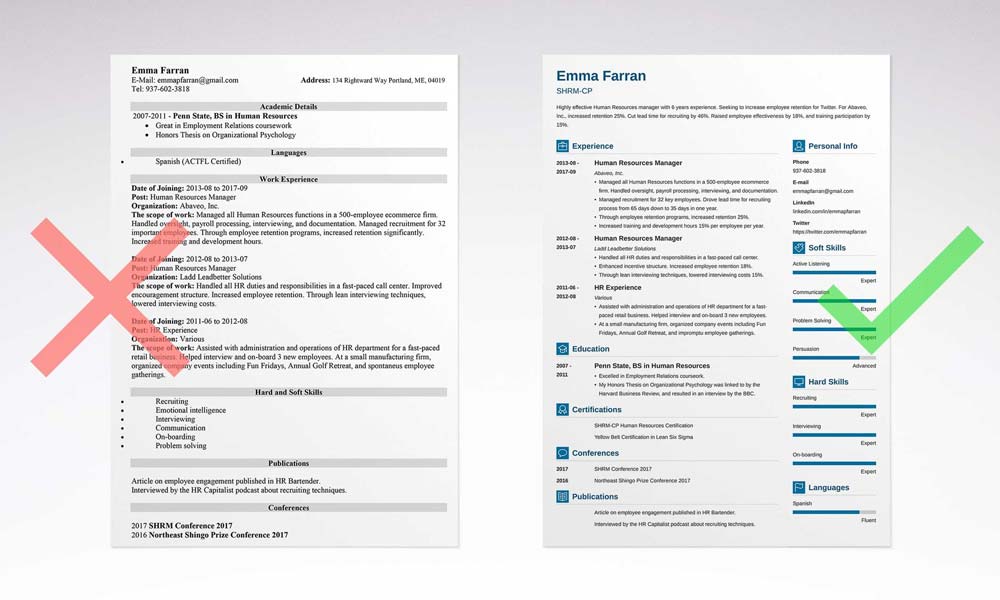Crafting a Standout Graphic Design Resume That Lands You the Job
If you're a graphic designer looking to land your dream job, your resume must appear in a bold font on a minimalist poster. A well-crafted graphic design resume tells a compelling story about you and shows your skills visually.
But, creating a resume that rises above the clutter and captures attention is challenging. You're not just listing past jobs—you're marketing yourself as a creative pro.
In this complete guide, we'll cover everything you need to know to make an impressive graphic design resume that gets you noticed.
Table of Contents
Why Your Resume Design Matters

Let's start with the obvious: graphic design is a visual profession. When applying for graphic design jobs, your resume is often the first sample of your work an employer sees.
A sloppy, lacklustre resume can derail your chances even if you have a fantastic portfolio website. It sends the wrong message, like showing up late for a client meeting with crumpled storyboards.
On the other hand, a carefully crafted resume design tells potential employers:
- You have strong attention to detail.
- You're passionate about design and care about your work.
- You understand typography, layout, colour theory and composition.
- You have good problem-solving skills and can work within constraints.
Your resume is also a branding tool—it's your first chance to show the unique perspective and talents you would bring to the role.
Just as good design solves problems, an effective graphic design resume should “solve” the problem of displaying your qualifications in an easy-to-digest, visually stunning way.
Tailor Your Design to the Job
Now that we've established the importance of design in your resume, let's talk strategy.
The first step is researching the company and role you're applying for. Tailor your resume design to the specific job. Show them you did your homework and understand their brand.
Here are some tips for customising your resume:
- Study their brand identity and aesthetics. Is their style minimalist and sleek? Retro and colourful? Use design elements that align with their visual branding.
- Emphasise relevant skills and achievements. Highlight your experience that's most applicable to the open position. Downplay anything less relevant.
- Use industry keywords. Scan the job description for essential terms and work those words into your resume, like “UX design,” “wireframing,” or “Adobe Creative Suite.”
- Show off the style they want to see. If you're applying for a fun startup, you have more latitude to be creative. A more polished, conservative design may be better for a corporate role.
Research will reveal what the company values in a designer—let those guiding principles shape your resume.
Choose the Right Format

Standard resumes are structured as a simple reverse-chronological list of past jobs. That format works, but a more visual resume format may suit designers. Here are some options:
Graphic Resume
This eye-catching format integrates visual elements like charts, icons, illustrations and colour blocks to break up text-heavy blocks. It allows you to showcase your design skills while efficiently communicating key details.
Pros:
- Lets your personality and design style shine.
- Draws attention with balanced use of text, graphics, and whitespace.
- Organises information clearly at a glance.
Cons:
- It can look busy or overwhelming if visuals aren't well-executed.
- It might not suit more conservative companies.
Portfolio Resume
An abbreviated portfolio highlighting your best work, with a short bio/skills section attached. Images, case studies, or brief project descriptions give tangible examples of what you can produce.
Pros:
- Summarises your capabilities as a designer at a glance.
- Let your work speak for itself.
- Focuses attention on your most substantial samples.
Cons:
- Very design-portfolio focused, with less emphasis on resume items like work history.
- It can look unbalanced if the visuals outweigh the text too much.
Infographic Resume
Use data visualisation like charts, graphs, timelines, and icons to convey your background and skills—Emphasise quantifiable achievements concisely.
Pros:
- Stands out from text-heavy resumes.
- Highlights results and competencies efficiently.
- Uses complex numbers to showcase concrete accomplishments.
Cons:
- Can oversimplify more complex skills and experience.
- The infographic style doesn't fit some corporate cultures.
- Potential lack of detail about past roles.
Single-Page Resume
Condenses all resume content onto one carefully designed page—forces you to streamline details and be concise.
Pros:
- Easy to digest at a glance.
- Minimal design creates a visual impact.
- Shows ability to consolidate information.
Cons:
- Sacrifices detail about work history.
- Minimal space to showcase capabilities.
- It can look cramped and busy if poorly executed.
10 Design Tips that Make You Stand Out

Once you've chosen the correct format for your resume, it's time to focus on the details. Here are ten design techniques that can take your resume from drab to fab:
1. Choose an eye-catching but legible font combination. Pair a clean, modern sans-serif font with a complementary decorative font for headers. Avoid weird fonts that are difficult to read.
2. Use negative space strategically. Whitespace helps guide the eye through different resume sections. Don't be afraid of space on the page.
3. Limit it to 2-3 colors max. Monochrome with one accent colour is a sophisticated, minimalist palette. Avoid rainbow overload.
4. Make resume sections visually distinct. Use boxes, dividing lines, background colours or other graphic elements to separate and call out sections.
5. Feature your best design work prominently. Showcase at least one stunning portfolio image on the first half of page one.
6. Use subtle graphic elements. Icons, lines, shapes and textures can enhance your resume without overdoing it.
7. Mix up your layout. Experiment with different alignments, text wrapping, multi-column and grid formats instead of a rigid block.
8. Make essential details pop. Use colour, lines, arrows or size to draw attention to critical parts, like job titles or achievement numbers.
9. Be selective with charts/graphs. A few concise infographics can visualise data effectively, but information overload looks messy.
10. Perfect the finishing touches. Review line spacing, margins, and alignment to polish your layout. Print and re-edit multiple times.
With careful attention to typography, colour, layout, and information design, you can create a resume that elevates your brand and puts your skills in the spotlight.
Elements to Include on a Graphic Design Resume

Optimising your resume goes beyond just listing past jobs. To create a compelling summary of your skills and experience, be sure to include:
Contact Information
At the top, provide your full name, phone number, email address, city, state, and links to professional social media profiles or your website. Make your name the most prominent and boldest text, so it's obvious who the resume belongs to.
Resume Profile or Objective
Next, add a short profile or objective section. In 2-4 sentences, explain the type of graphic design role you seek and highlight a few essential skills or areas of expertise. This gives the reader immediate insight into what you have to offer.
Work Experience
This section forms the meat of your resume. List your jobs in reverse chronological order, starting with the most recent. Include the company name, position title, employment dates, and location. Use bullet points to summarise your responsibilities and highlight critical achievements. Tailor each job listing to include details relevant to the role you're applying for.
For design roles, be specific. Examples include “Created 20+ display ads improving clickthrough rates by 15%” or “Led rebranding initiative to update company logo and style guide.” This quantifiable information stands out.
Education
List degrees earned, field of study, school names, and graduation years. Awards, special programs, or certifications can be included too. Recent graduates may move education above work experience.
Skills
Include a concise list of tangible design abilities and software proficiency necessary for the desired role. Back up claims by referencing projects in the work experience section. Break skills into logical categories like:
- Design Skills: Typography, Color Theory, Wireframing, Animation
- Software Skills: Adobe Creative Suite, Figma, Blender, HTML/CSS
- Interpersonal Skills: Team Collaboration, Client Relations, Communication
Portfolio Link
Add a link to your design portfolio website so hiring managers can view samples of your work.
Graphic Design Resume Dos and Don'ts
Crafting your resume takes thoughtfulness and restraint. Follow these dos and don'ts:
Do:
- Highlight transferable skills – What skills from past jobs apply to the one you want? Feature those prominently.
- Showcase a range – Include diverse work samples and skills tailored to the job.
- Use resume keywords – Research terms and skills that repeatedly pop up for similar roles and work them into your resume. This helps get past AI filters.
- Check for errors – Typos or inconsistencies may return your resume to the discard pile.
Don't:
- Exaggerate – Be truthful. Lying on your resume can cost you the job later.
- Use busy templates – Overly ornate resume templates distract from the content. Go for clean and straightforward.
- List unrelated skills – Keep your resume focused on the target graphic design job.
- Make it too long – Respect the 7-second scan rule. Cut content that doesn't directly support your candidacy.
Crafting Each Resume Section

Now that you know what to include and avoid, let's dive deeper into crafting stellar content for each resume section.
Contact Info Section
This content needs to be 100% accurate and easy to scan:
- Name – Use your full name (or first/middle/last) in large, bold font at the top. Underline or make it a different colour if desired.
- Phone number – Use the number you're most likely to answer and check your voicemail regularly. Set up a professional voicemail message.
- Email – Create an email for job applications using your name, like jo***************@gm***.com. Check it frequently.
- City, state – List your current location or preferred work location.
- Links – Add links to your website, LinkedIn, Dribbble, Instagram, or other online portfolios. Customise these links for each application.
Resume Profile/Objective Section
In a few concise, vibrant sentences, explain who you are, the graphic design role you seek, and the value you offer. For example:
“Award-winning graphic designer with 5+ years experience creating logos, publications, and marketing materials. Seeking a full-time position at a forward-thinking design firm to contribute creativity and innovative problem-solving. Passionate about user-centered design and brand development.”
This section shows personality while positioning you as a qualified candidate. Adjust the profile for each application.
Work Experience Section
This section needs to demonstrate the relevance of your experience. For each role, include:
- Job title and company – Use official titles that communicate your position and level of responsibility—list company name and location.
- Employment dates – Provide start and end dates showing progression: list month and year.
- Job Summary – In 3-5 concise bullet points, highlight specific projects, skills used, achievements, and quantifiable results. Focus on details that align with the desired role.
To illustrate, instead of a generic bullet like “Created print advertisements,” use something like: “Created five award-winning print ad campaigns that increased consumer engagement by 20%.”
Education Section
Keep this section simple and scannable:
- List degree earned, major/concentration, university name, and graduation year.
- Add GPAs over 3.5, academic honours, or special certifications like “Dean's List”.
- You can include study abroad programs, internships, or relevant coursework like typography and web design classes.
- Once you have a few years of experience, education can be brief. Recent grads may prioritise this section near the top.
Skills Section
The skills section needs to paint you as a well-rounded, proficient designer. Strategic tips:
- Break skills into logical categories like design expertise, software proficiency, and soft skills. Use bullet points or columns to format them cleanly.
- First, list the most relevant skills for each category's desired graphic design role. Draw the reader's eye to those skills.
- Only include skills you are genuinely proficient in. Your interview or work samples will reveal any exaggerations.
- Soft skills like communication, collaboration, and creativity are just as necessary as technical skills for design work. Don't downplay them.
Portfolio Section
Your resume should include a link to your professional design portfolio website. This shows the hiring manager examples of your work.
When formatting the link:
- Use a custom domain name, like www.YourNameDesign.com. Avoid linking out to a general site like Behance.
- Make the link text bold and enticing, like “View Graphic Design Portfolio.” Don't just say “Portfolio” or use the URL.
- Double-check that the link works! Test it from outside your network.
- Customise your portfolio content for each application, highlighting projects using skills needed for that particular graphic design job.
References Section
You do not need to list references on your graphic design resume. End with the line “References available upon request.” This signals that you have references ready if required.
Bring a separate reference sheet with 3-5 names, titles, and contact info to interviews. Only provide references if asked by a potential employer. Alert your references so that they may be contacted.
Turning Your Resume Into a Full Brand

Consider creating complimentary branded assets that work cohesively with your resume design to take your application to the next level. These could include:
Cover Letter
A matching cover letter with header and graphics that tie into your brand. This shows continuity when sent with your resume.
Business Card
A business card to hand out during interviews, networking events, conferences and more. Bonus points if you design one yourself!
LinkedIn Profile
Customise your LinkedIn with a sharp profile photo, header image, and summary aligned to your resume.
Portfolio Website
Having an online portfolio website designed around your brand is hugely influential. Include case studies and embed images and videos directly showcasing your best work.
Custom Swag
Take it up a notch by having branded t-shirts, stickers, or notebooks featuring your logo and designs. Wear a matching shirt to an interview to make a bold impression.
5 FAQs About Creating a Graphic Design Resume
Should I include references on my graphic design resume?
References don't need to take up valuable real estate on your actual resume. Add a line that says “References available upon request” instead.
Can I use graphics and text boxes on my resume?
Yes, done tastefully; graphs, icons, and text boxes can visually enhance your resume. Just don't overdo it. Make sure the text is still easily readable.
What file type should I use to submit my resume?
PDF is the standard format for resumes. It maintains your original formatting and layout. Make sure the file name includes your name, like “Firstname_Lastname_Resume.pdf”.
How can I highlight soft skills on a design resume?
Using bullet points, call out intangibles like communication, collaboration, and time management under a Skills or Expertise section.
Should I put my GPA on my resume?
Only if it's high (3.8+) and you have limited work experience. For most designers, GPA isn't critical and takes up space better used for skills.
Start Designing an Attention-Grabbing Resume
You made it through our crash course on creating a stellar graphic designer resume! By now, you should have all the tools you need to build your own—from format and layout to content and style dos and don'ts.
Remember, your resume is just the first step to landing the interview. Once you're in the door, you'll still need to back up the marketing with substance. So continue honing those design skills in the meantime! The proper role is out there waiting for talented pros like you who take the time to craft both beautiful visuals and persuasive written content.
Now, get started designing a resume that spotlights everything you offer. Use this guide as a reference to artfully arrange your background in the best light possible. Before you know it, you could have exciting new design projects filling up your portfolio.
So what are you waiting for? Go and create something unique!
